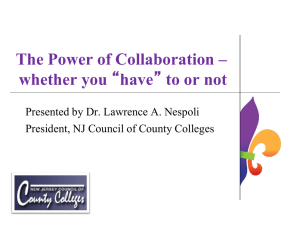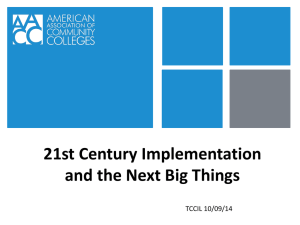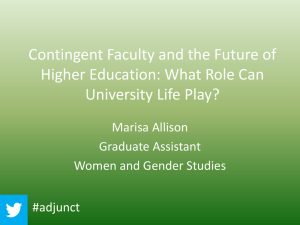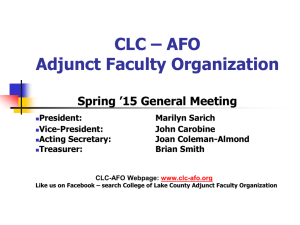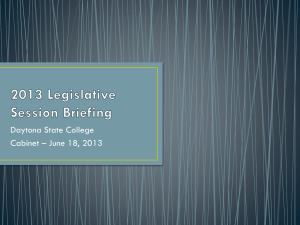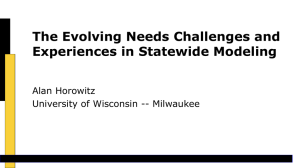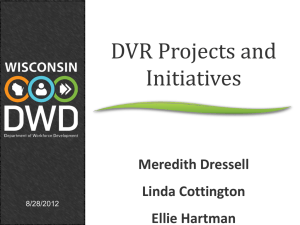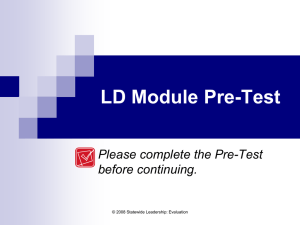Welcome to my Presentation - New Jersey Council of County Colleges
advertisement
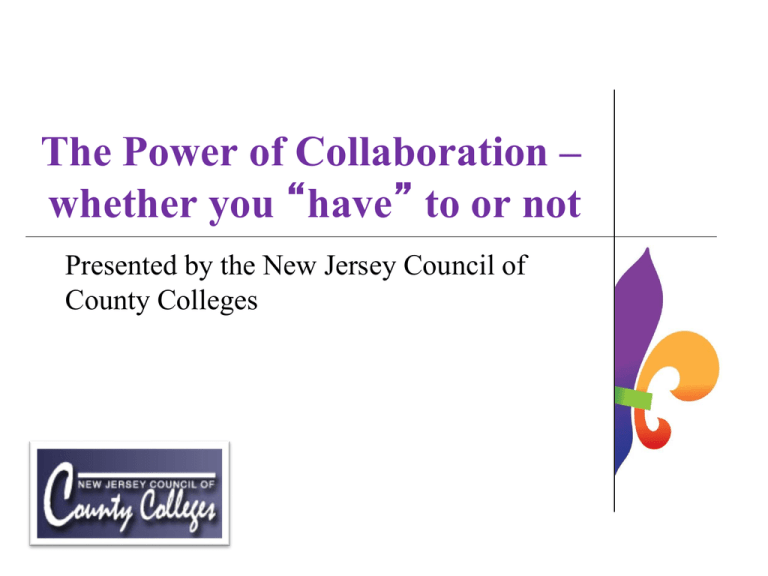
The Power of Collaboration – whether you “have” to or not Presented by the New Jersey Council of County Colleges Presenters Patricia Donohue, President Joann LaPerla Morales, President Mercer County Community College Middlesex County College Lawrence Nespoli, President New Jersey Council of County Colleges 2 New Jersey 19 community colleges 400,000 students Decentralized higher education system “Coordinated autonomy” New Jersey Council of County Colleges and its role 3 Trustee’s Perspective Community colleges experiencing “climate change” – slowing government aid and increasing enrollments Trustees especially concerned about long-term stability Decided to begin the “Big Ideas Project” to research strategies to increase efficiency and capacity Receive regular reports and bi-annual updates at state-wide trustee retreats 4 Presidents Perspective NJ presidents knew that colleges needed to: Act collectively to create sustainable solutions – even though we aren’t “required” to work together Shift from “Access” to “Access TO Success” Enhance accountability 5 From Idea to Plan Engaged presidents, faculty, and staff from across the state over 18 months to create a plan Using 8 statewide working “affinity groups” to begin implementation work in 8 distinct areas. 6 #1- Transforming Developmental Education, Testing, and Placement Group Focus: Building a common commitment to transforming developmental education and improving community college testing and placement. Major Strategies: • • • • • Offer Multiple Evidence-Based, Successful Developmental Education Models Consistent with the Needs of the Students. Improve Accountability for Developmental Education Using the Student Success Model (developed by Group Three). Identify Alternatives for At-Risk, Underprepared Students. Build Statewide Approaches to Disseminating Best Developmental Education Programs. Initiate Statewide Conversation about ESL Pathways and How ESL Relates to Developmental Education Pathways. 7 What has happened this year? Established a process which sets out two broad approaches: • • The development of specific strategic principles intended to reform the delivery of developmental education and its impact on overall institutional culture. The content elements needed for the planning and delivery of a sector wide fall conference to disseminate these ideas with accompanying models. This is a process intended to engage faculty as a major source of input. Three broad areas of interest have developed through the process: • College Readiness and Educational Sequencing • Instructional Strategies (e.g., acceleration and modularization) and Support Structures (e.g., student success courses) • Data Tracking 8 What has happened this year? A statewide survey on ESL Instruction has been distributed to all ESL Coordinators on our 19 campuses. • This survey has been broken down by credit and non-credit ESL courses to give us a better snap shot of the various student needs. 9 #2- Aligning Expectations Group Focus: Working collaboratively with K-12 and state leaders to align expectations between K-12 and community colleges. Major Strategies: • • • • • Expand Implementation of College Readiness Diagnostic Assessments at the High School Level. Expand Implementation of Strategic Interventions. Collaborate with New Jersey Department of Education and Local School Districts on the Implementation of Common Core, including Assessment. Align High School Common Core with Higher Education Curriculum and Learning Outcomes. Create High Quality Professional Development Programs for Language Arts and Mathematics for Teachers. 10 What has happened this year? Developed an inventory of efforts across all 19 colleges that demonstrate K-12 collaboration intended to increase college readiness. • Faculty are presently being identified to serve as test item reviewers to reach alignment with the PARCC initiative. Identified partnerships with K-12 leaders working to implement the “common core” and related assessments. Served on Governor’s college and career readiness task force that developed statewide “Speed Up/Catch Up” program Forged relationships built on consistency and trust in which, over time, we continue to author innovative ideas. 11 #3- Enhancing Student Success Data Group Focus: Creating a more comprehensive student success model that included metrics on progression through developmental education and disaggregated success measures by: a) students who enter community college prepared for college level work; b) students who require developmental education; and c) ESL students. Major Strategy: Develop a more comprehensive student success model that considers entering student skill level impact on success within a defined period of time. 12 What has happened this year? Developed a new student success model to better track and monitor the progress of students in developmental education. A 5-college pilot will provide information on: • Student remedial placement. • Success in remedial classes. • Student retention, completion and transfer to senior postsecondary institutions. 13 #4- Promoting Adjunct Faculty Development Group Focus: Developing programs to support regional and statewide collaboration for adjunct faculty development. Major Strategies: • Developed a statewide credential and adjunct faculty orientation program to provide professional development for the adjunct faculty who work in the New Jersey community college sector. • Developed a program for sharing and supporting best practices related to instruction methods and practices for adjunct faculty. 14 What has happened this year? Surveyed the Adjunct Faculty Coordinators on our 19 campuses with questions pertaining to the following: • Adjunct Faculty Development Programs on our campuses. • Existing mentoring models. • Information dissemination/Resources available for Adjunct Faculty. • Informing adjunct faculty on legal aspects of teaching (i.e. FERPA, diversity, record retention requirements). • And, important to note, what additional support our coordinators think our adjunct faculty need. Through this survey, have collected materials relating to: • • • • Orientation checklists (i.e. human resources, payroll, IT, etc.). Compliance materials. Effective instructional delivery techniques. Adjunct Faculty Handbooks. 15 What has happened this year? Through our data collection, we aim to develop: • • • • • A statewide template for adjunct faculty orientation. A statewide credential program for adjunct faculty along with the framework for a job bank. A statewide model for mentoring to be implemented by individual colleges. An online infrastructure for disseminating professional development activities for adjunct faculty. Annual regional conferences for adjunct faculty. 16 #5- Promoting Joint Purchasing Group Focus: Enhancing the work of the current New Jersey Joint Purchasing Consortium to achieve greater cost savings. Major Strategy: Enable the New Jersey Joint Purchasing Consortium to achieve greater cost savings by working systematically to leverage the collective purchasing power of the sector. 17 What has happened this year? Developed a business plan for a self-supporting joint purchasing consortium across the community college sector. The plan outlines the following for our Presidents: • A proposed business model, budget, allocation formula, assessment tools, and communications and technology infrastructure. • Use of national purchasing consortia. 18 #6- Promoting Academic Consortia Group Focus: Developing mechanisms for enhanced consortia arrangements among the 19 community colleges. Major Strategies: • Create a New Jersey Distance Learning Consortium. • Create an environmental scanning structure to foster other academic consortia among the 19 community colleges. 19 What has happened this year? Explored E-Tutoring options. Conducted training day with Quality Matters. • Now exploring a statewide conference by Quality Matters. Established work groups to: • Identify opportunities for shared services to reduce costs in support of student success: • Online tutoring, orientation/student readiness, faculty intervention. • Develop faculty focused initiatives in such areas as: • Training/pedagogy, Quality Matters, Adjunct Reporting, E-mentoring. 20 #7- Building Alternate Delivery Learning Systems Group Focus: Designing and implementing new best practice teaching and learning methods together with new and emerging technologies. Major Strategies: • • • • • Engage discovery, experiential learning, or technology enhanced curricular delivery. Develop a plan for a unified system of mobile delivery. Integrate the use of mobile device as a ubiquitous tool to enhance active teaching and learning, and access to services. Foster engagement between and among students, faculty, and staff through the use of collaborative online strategies. Expand the use of social media to enhance teaching, learning and services. 21 What has happened this year? Conducted sector wide survey to gauge mobile readiness on our campuses. • • • All colleges are found to be using mobile; they have been found to be mobile ready Mobile readiness was defined as the ability of our students to access and interact with our websites, ERP systems, Learning Management Systems, etc. A report with recommendations about mobile readiness addressing issues of support, security, data transformation, and transition is eminent. Survey indicates that use of social media is less prevalent with no defined best practices. • The IT Affinity group will engage in a sector wide dialogue to identify ways in which they can improve collaboration, classroom announcements and student engagement through social media. #8- Developing Core Learning Outcomes and Common Assessment Tools Group Focus: Developing core learning outcomes and common assessment tools for the top 10 high enrollment general education courses. Major Strategy: • Establish statewide initiative to develop: • Core course content and learning outcomes for the top 10 highest enrollment general education courses. • An comprehensive inventory of instructional best practices. • Common assessment tools. • Faculty training and development tools. 23 What has happened this year? Engaged in a process of surveying all faculty from each of the top ten general education courses within the sector to identify what they believe are the core learning outcomes for their respective courses: • Each survey is unique to its respective discipline. • Survey content is informed by already established course syllabi collected from each of the colleges. • To date, we have surveyed five general education courses, with five more to follow in Fall 2012. 24 Connecting to National Networks and State Policymakers Presentation of student success “Charter” to legislative education committees. Established statewide and college graduation targets through the year 2020. Partnering with Governor’s Office on K-12 reform. Statewide communications strategies on the “Big Ideas.” Three community colleges are partnering with Achieving the Dream to serve as regional hubs to promote student success initiatives statewide. 25 A Note on Collaboration Collaboration is very hard work. It takes a lot of time to communicate effectively in a statewide initiative. But the value added is very significant. 26 Q&A Questions? 27 Information For the following information, please visit: www.njccc.org/bigideas.htm Big Ideas Research Papers Big Ideas Statewide Recommendations Big Ideas Implementation Updates Or contact us directly at: New Jersey Council of County Colleges 330 West State Street Trenton, NJ 08618 609-392-3434 www.njccc.org info@njccc.org 28
